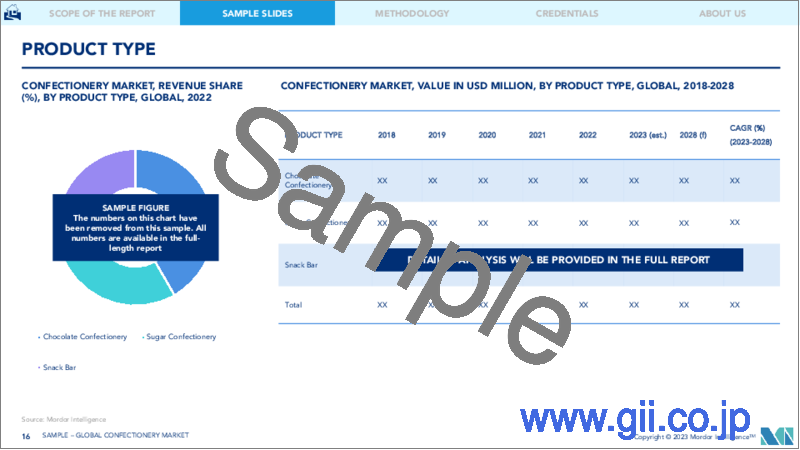|
|
市場調査レポート
商品コード
1190410
菓子類市場- 成長、動向、予測(2023年-2028年)Confectionery Market - Growth, Trends, and Forecasts (2023 - 2028) |
||||||
|
● お客様のご希望に応じて、既存データの加工や未掲載情報(例:国別セグメント)の追加などの対応が可能です。 詳細はお問い合わせください。 |
|||||||
| 菓子類市場- 成長、動向、予測(2023年-2028年) |
|
出版日: 2023年01月18日
発行: Mordor Intelligence
ページ情報: 英文 172 Pages
納期: 2~3営業日
|
- 全表示
- 概要
- 目次
菓子類の世界市場は、今後5年間にCAGR4.2%で成長すると予測されています。
健康的な間食の傾向が続いており、適切な味と十分な栄養価に加え、便利な間食の人気が消費者の間で高まっており、菓子類市場を後押ししています。砂糖やチョコレート製品の人気に伴い、菓子食品のオーガニックスナック分野が世界市場で人気を博しています。消費者は、低カロリー、高カカオ、機能性成分を使用した菓子類など、より健康的な選択肢を求めているのです。菓子類のラベルに記載される機能性表示は、急速に拡大しています。
近代化の進展や、仕事と私生活を両立させる多忙なライフスタイルは、調理が簡単ですぐに食べられる食品を好むため、日常の食生活に便利なスナックの需要を誘発する主な要因の一部となっています。また、スナックバーは、より健康的な代替菓子類として認識されており、タンパク質、低炭水化物、低糖など様々な栄養を含む製品バリエーションがあるため、新しい世代の間で非常に好まれています。
肥満の原因となる高糖質は、消費者の間で深刻な問題となっています。低カロリー、高カカオ、機能性素材を使用した菓子類など、消費者はより健康的な選択肢を求めています。菓子類のラベルに記載される機能性表示は、急速に拡大しています。そのため、チョコレートやスナックバー、無糖チューインガムなど、無糖、低脂肪、高タンパクの菓子類への需要が高まり、菓子類市場は世界的に拡大すると予想されています。
菓子類の市場動向
オーガニック・スナックとクリーンラベル・スナックへの需要の増加
消費者の間では、利便性と味覚に加え、より健康的なスナックの需要が高まっており、巨大企業が採用する主要な戦略となっています。最近では、深刻な健康問題を引き起こす可能性のある化学物質を一切含まない、オーガニックチョコレートの需要が高まっています。消費者は、健康と幸福を意識しているため、ビーガン、オーガニック、グルテンフリー、シュガーフリーのチョコレートを好んでいます。そのため、さまざまな巨大菓子類企業が、消費者が少しずつ食べて残りを保存できるような革新的なパッケージの最新のフレーバーチョコレートを発表しています。また、オーガニックチョコレートの輸出の増加も、オーガニックベースの菓子類市場の需要を押し上げると予想されます。大手企業は、変化する顧客の要求を満たすために、オーガニックチョコレートに機能性成分、トロピカルフルーツ、フレーバーフィリング、ナッツベースやエキゾチックなフレーバーを加えることで、製品レンジを拡大しています。このことは、世界の菓子市場を連続的に加速させています。
アジア太平洋地域は菓子市場の主要なシェアを占めています。
アジア太平洋地域は、都市化が進み、機能性菓子類や飲食品が入手しやすくなっていることから、かなりの成長を遂げると予測されています。インドや日本などのアジア太平洋地域では、無糖菓子や低炭水化物などの低カロリー製品の需要が高く、アジア料理の多くは健康的で栄養価が高いためです。したがって、予測期間中に世界の菓子類市場が緩やかに成長する原動力となることが期待されます。アジア諸国では、砂糖の大量摂取がいくつかの健康問題を引き起こすため、無糖の菓子類にシフトしています。無糖のチョコレートやガムを作るには、一般的に糖アルコールと人工甘味料という2種類の甘味料が使用されます。例えば、米国の大手チョコレートメーカーであるHersheyは、HersheyやReese'sなどの主要ブランドで、砂糖の代わりにマルチトールとポリグリシトールを使用した無糖のバリエーションを展開しています。
菓子類市場の競合分析
世界的に巨大な存在感と幅広い流通網を持つMars Incorporated、Mondelez International、Ferrero Group、Mondelez International、Nestle SAなどの主要企業が世界の菓子類市場で大きなシェアを占めています。主要企業は、地理的範囲を拡大し、顧客基盤を増やすために、製品のオンラインマーケティングとブランディングのためのオンライン流通チャネルに焦点を当てています。菓子類市場の大手メーカーは、収入基盤を拡大するために、中国やインドなどの新興市場がもたらす機会を活用することに注力しています。これは、所得水準の上昇と、フルーツやナッツをベースにしたチョコレート、ダークチョコレート、フレーバーチョコレートなどの多様な製品ポートフォリオに起因する、さまざまな種類の菓子類への嗜好によるものです。
その他の特典。
- エクセル形式の市場予測(ME)シート
- アナリストによる3ヶ月間のサポート
目次
第1章 イントロダクション
- 調査の前提条件と市場の定義
- 調査対象範囲
第2章 調査手法
第3章 エグゼクティブサマリー
第4章 市場力学
- 市場促進要因
- 市場抑制要因
- ポーターのファイブフォース分析
- 新規参入業者の脅威
- 買い手/消費者の交渉力
- 供給企業の交渉力
- 代替品の脅威
- 競争企業間の敵対関係
第5章 市場セグメンテーション
- 製品タイプ
- チョコレート菓子
- ダークチョコレート
- ホワイトチョコレート、ミルクチョコレート
- 砂糖菓子類
- ボイルド・スイーツ
- トフィー・キャラメル・ヌガー
- トローチ・ガム・ゼリー・チューズ
- ミント
- その他の砂糖菓子類
- スナック菓子
- シリアルバー
- エナジーバー
- その他スナック菓子
- チョコレート菓子
- 流通経路
- スーパーマーケット/ハイパーマーケット
- 専門小売店
- オンラインショップ
- コンビニエンスストア
- その他の流通チャネル
- 地域別
- 北米
- 米国
- カナダ
- メキシコ
- その他北米地域
- 欧州
- ドイツ
- 英国
- イタリア
- スペイン
- フランス
- ロシア
- その他の欧州地域
- アジア太平洋地域
- 中国
- 日本
- インド
- オーストラリア
- その他アジア太平洋地域
- 南米
- ブラジル
- アルゼンチン
- その他の南米地域
- 中東・アフリカ地域
- サウジアラビア
- 南アフリカ
- その他の中東・アフリカ地域
- 北米
第6章 競合情勢
- 最も採用されている戦略
- 市場シェア分析
- 企業プロファイル
- Mars, Incorporated
- Ferrero International SA
- Nestle SA
- Mondelez International Inc
- Meiji Holdings Co. Ltd
- The Hershey Company
- Chocoladefabriken Lindt & Sprungli AG
- EZAKI GLICO Co. Ltd
- Crown Confectionery
- HARIBO GmbH & Co. KG
第7章 市場機会と今後の動向
The global confectionery market is projected to grow at a CAGR of 4.2% over the next five years.
The ongoing trend of healthier snacking and the popularity of convenient snacking, along with appropriate taste and adequate nutritional benefits, is rising among consumers, boosting the confectionery market. With the popularity of sugar and chocolate products, the organic snack segments of confectionary food items have gained traction in the global market. Consumers seek healthier options, such as low-calorie, high-cocoa, and functional ingredient-based confectionery. Functional claim on confectionery product labels is growing rapidly.
Rising modernization and a hectic lifestyle balancing professional & personal life are a few of the major attributes triggering the demand for convenience snacks in the everyday diet as they prefer having easy-to-cook and quick-to-eat food commodities. Also, snack bars are commonly perceived as a healthier alternative confectionery food, and due to their product variation, in terms of the different nutrition, such as proteins, low carb, and low sugar, these product has been highly preferred among new generations.
High sugar content related to obesity is a severe concern among consumers. Consumers seek healthier options, such as low-calorie, high-cocoa, and functional ingredient-based confectionery. Functional claim on confectionery product labels is growing rapidly. Thus, the demand for a sugar-free, low cab, high-protein confectionary foods such as chocolates and snacks bar and sugar-free chewing gum was growing and anticipated to boost the confectionary food market globally.
Confectionery Market Trends
Increasing Demand for Organic and Clean Label Snacks
Healthier snacking, along with convenience and taste, is the rising trend among consumers, which is the major strategy adopted by giant companies due to the increasing demand for healthy snacks. The demand for organic chocolate is rising nowadays as it does not contain any added chemicals, which can cause severe health issues. Consumers prefer vegan, organic, gluten-free, and sugar-free chocolates as they are conscious of their health and wellness. Thus, various giant confectionery companies are introducing the latest flavored chocolates with innovative packaging that lets consumers consume them in small portions and preserve the rest for later. The increase in exports for organic chocolates is also expected to drive the demand for the organic-based confectionery market. Major companies are expanding their product range by concluding functional ingredients, tropical fruit, flavor fillings, and nut-based and exotic flavors in organic chocolates to fulfill changing customer demands. This consecutively accelerates the confectionary market globally.
Healthier snacking, along with convenience and taste, is the rising trend among consumers, which is the major strategy adopted by giant companies due to the increasing demand for healthy snacks. The demand for organic chocolate is rising nowadays as it does not contain any added chemicals, which can cause severe health issues. Consumers prefer vegan, organic, gluten-free, and sugar-free chocolates as they are conscious of their health and wellness. Thus, various giant confectionery companies are introducing the latest flavored chocolates with innovative packaging that lets consumers consume them in small portions and preserve the rest for later. The increase in exports for organic chocolates is also expected to drive the demand for the organic-based confectionery market. Major companies are expanding their product range by concluding functional ingredients, tropical fruit, flavor fillings, and nut-based and exotic flavors in organic chocolates to fulfill changing customer demands. This consecutively accelerates the confectionary market globally.
Asia-Pacific Holds Major Share in Confectionary Market
Asia-Pacific is predicted to witness considerable growth, owing to the increasing urbanization and easy accessibility and availability of functional confectionery food and beverages over the regions. Demand for low-calorie products, such as sugar-free confectionaries and low carbs, is high in the Asia-Pacific areas like India and Japan, as most of the Asian cuisine is healthy and nutritious. Thus, it is expected to be the driving force behind the modest growth in the global confectionery market over the forecast period. Asian countries are shifting toward sugar-free confectionaries as high sugar intake causes several health issues. To make sugar-free chocolate and gums, two classes of sweeteners are typically used, namely sugar alcohols and artificial sweeteners. For instance, Hershey, the leading US-based chocolate player, has sugar-free variants for leading brands, such as Hershey and Reese's, which use maltitol and polyglycitol instead of sugar.
Confectionery Market Competitive Analysis
With a huge global presence and wide distribution networks, the key players, such as Mars Incorporated, Mondelez International, Ferrero Group, Mondelez International, and Nestle SA, hold prominent shares in the global confectionery market. Key players are focusing on online distribution channels for their online marketing and branding of their products in order to expand their geographic reach and increase their customer base. Leading manufacturers in the confectionery market are focusing on leveraging opportunities posed by emerging markets, like China and India, to expand their revenue base because of the rising income levels and preference for different confectionery products type, owing to the diversified product portfolio, which includes fruit and nut-based chocolates, dark chocolates, and flavored chocolates.
Additional Benefits:
- The market estimate (ME) sheet in Excel format
- 3 months of analyst support
TABLE OF CONTENTS
1 INTRODUCTION
- 1.1 Study Assumptions and Market Definition
- 1.2 Scope of the Study
2 RESEARCH METHODOLOGY
3 EXECUTIVE SUMMARY
4 MARKET DYNAMICS
- 4.1 Market Drivers
- 4.2 Market Restraints
- 4.3 Porter's Five Forces Analysis
- 4.3.1 Threat of New Entrants
- 4.3.2 Bargaining Power of Buyers/Consumers
- 4.3.3 Bargaining Power of Suppliers
- 4.3.4 Threat of Substitute Products
- 4.3.5 Intensity of Competitive Rivalry
5 MARKET SEGMENTATION
- 5.1 Product Type
- 5.1.1 Chocolate Confectionary
- 5.1.1.1 Dark Chocolate
- 5.1.1.2 White and Milk Chocolate
- 5.1.2 Sugar Confectionery
- 5.1.2.1 Boiled Sweets
- 5.1.2.2 Toffees, Caramels and Nougat
- 5.1.2.3 Pastilles, Gums, Jellies and Chews
- 5.1.2.4 Mints
- 5.1.2.5 Other Sugar Confectioneries
- 5.1.3 Snack Bar
- 5.1.3.1 Cereal Bars
- 5.1.3.2 Energy Bars
- 5.1.3.3 Other Snack bars
- 5.1.1 Chocolate Confectionary
- 5.2 Distribution Channel
- 5.2.1 Supermarket/Hypermarket
- 5.2.2 Specialist Retailers
- 5.2.3 Online Retail Stores
- 5.2.4 Convenience Stores
- 5.2.5 Other Distribution Channels
- 5.3 Geography
- 5.3.1 North America
- 5.3.1.1 United States
- 5.3.1.2 Canada
- 5.3.1.3 Mexico
- 5.3.1.4 Rest of North America
- 5.3.2 Europe
- 5.3.2.1 Germany
- 5.3.2.2 United Kingdom
- 5.3.2.3 Italy
- 5.3.2.4 Spain
- 5.3.2.5 France
- 5.3.2.6 Russia
- 5.3.2.7 Rest of Europe
- 5.3.3 Asia-Pacific
- 5.3.3.1 China
- 5.3.3.2 Japan
- 5.3.3.3 India
- 5.3.3.4 Australia
- 5.3.3.5 Rest of Asia-Pacific
- 5.3.4 South America
- 5.3.4.1 Brazil
- 5.3.4.2 Argentina
- 5.3.4.3 Rest of South America
- 5.3.5 Middle East and Africa
- 5.3.5.1 Saudi Arabia
- 5.3.5.2 South Africa
- 5.3.5.3 Rest of Middle East andAfrica
- 5.3.1 North America
6 COMPETITIVE LANDSCAPE
- 6.1 Most Adopted Strategies
- 6.2 Market Share Analysis
- 6.3 Company Profiles
- 6.3.1 Mars, Incorporated
- 6.3.2 Ferrero International SA
- 6.3.3 Nestle SA
- 6.3.4 Mondelez International Inc
- 6.3.5 Meiji Holdings Co. Ltd
- 6.3.6 The Hershey Company
- 6.3.7 Chocoladefabriken Lindt & Sprungli AG
- 6.3.8 EZAKI GLICO Co. Ltd
- 6.3.9 Crown Confectionery
- 6.3.10 HARIBO GmbH & Co. KG




